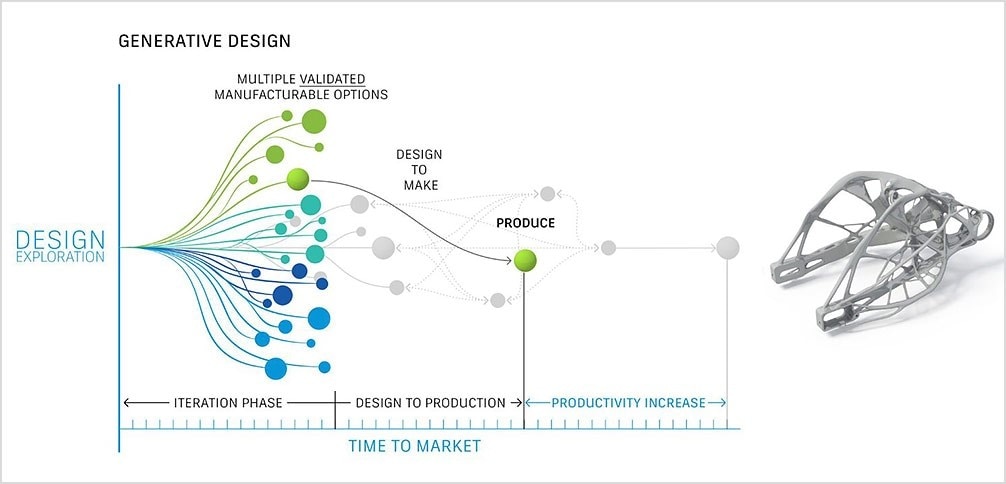Generative AI Product Design
Introduction to Generative Design
Generative design is a new approach to design that uses algorithms and AI-powered software to create and optimize product designs. It is a departure from traditional design methods, which typically involve a designer creating a product design based on a set of requirements and constraints.
Generative design, on the other hand, involves defining a set of design goals and constraints and letting a computer algorithm generate a range of possible design options that meet those criteria. This approach allows for more creative exploration of design possibilities while also streamlining the design process.
Generative AI in Design and Engineering
Generative design is being used in a wide range of industries, from automotive and aerospace to consumer goods and architecture. In the automotive industry, for example, generative design is being used to create lightweight and efficient parts that reduce fuel consumption.
To improve performance, weight reduction plays a vital role, and the Briggs Automotive Company (BAC) has effectively utilized generative design to optimize and fabricate innovative wheels for its street-legal race car, the BAC Mono. By using this technology, the BAC Mono’s wheels are now more lightweight, durable, and stronger than ever before.
As a result, the car’s acceleration and handling have significantly improved, providing a more thrilling and exhilarating driving experience. The use of generative design not only improved the car’s performance but also reduced production costs and time, making it an excellent example of how innovative technology can enhance the automobile industry.
In architecture, generative design is being used to create complex building structures that are optimized for energy efficiency and structural stability. In the consumer goods industry, generative design is being used to create products that are not only aesthetically pleasing but also more efficient and sustainable.
Generative design plays a significant role in manufacturing by automatically generating design options that meet your requirements, improving efficiency. This is especially important when parts or tools must fit into an established workflow or pipeline, where retooling can be disruptive and expensive.
With generative design software such as Autodesk Fusion 360, designers can explore countless variations to minimize weight or material costs, maximize performance metrics, and experiment within tight restrictions. Introducing generative design to existing manufacturing processes such as additive manufacturing, CNC machining, and casting can enhance product performance, reduce costs, and enable exploration of innovative design concepts. By leveraging the benefits of generative design, manufacturers can optimize their processes and stay ahead in the highly competitive manufacturing industry.
Benefits of Generative Design

One of the main benefits of generative design is that it allows designers to quickly generate and evaluate a large number of design options. This can help speed up the design process and reduce costs by eliminating the need for manual design iterations.
Generative design can also help identify design options that may not have been considered using traditional design methods. By exploring a wider range of design possibilities, designers can create more innovative and efficient products.
Another advantage of generative design is that it can be used to optimize designs for specific manufacturing processes or materials. By taking into account manufacturing constraints from the outset, generative design can help create products that are easier and cheaper to produce.

Generative AI Product Design – Case Studies
One example of a successful project that utilized generative design is Airbus’ A320neo aircraft. The company used generative design to optimize the design of the aircraft’s wingtip, resulting in a 3.5% reduction in fuel consumption.
Another example is the Adidas Futurecraft 4D shoe. Adidas used generative design to create a lattice-like structure in the sole of the shoe, which provides cushioning and support while also being lightweight and durable.
The Future of Generative Design
As AI technology continues to improve, we can expect to see even more advancements in generative design in the coming years. One potential area of development is the ability to incorporate real-time feedback from sensors and other sources into the design process, allowing for more dynamic and responsive product designs.
Another area of development is the use of generative design for multi-disciplinary design optimization. This involves optimizing not just the product design itself but also the manufacturing process, materials, and supply chain.
Ethical Considerations
As with any emerging technology, there are ethical implications to consider when it comes to generative design. One potential issue is the displacement of human designers and engineers. As generative design becomes more sophisticated, there is a risk that it could replace the need for human designers altogether.
Another potential ethical issue is the potential for generative design to create products that are optimized for efficiency and cost savings at the expense of other factors, such as safety or environmental impact. It will be important for companies to ensure that ethical considerations are taken into account when using generative design.
Tips for Implementing Generative Design
For companies interested in adopting generative design, there are a few best practices to keep in mind. First, it’s important to have a clear understanding of the design goals and constraints before beginning the generative design process.
It’s also important to have a team of designers and engineers who are familiar with the generative design software and can provide feedback and guidance throughout the process. Finally, It’s important to evaluate and test the generated designs thoroughly to ensure that they meet all the necessary requirements and are feasible to manufacture.
Another key consideration when implementing generative design is the need for high-quality data. Generative design algorithms rely on accurate data inputs to create effective designs, so it’s important to ensure that the data being used is reliable and up-to-date.
Finally, it’s important to recognize that generative design is not a one-size-fits-all solution. While it can be a powerful tool for certain design applications, there may be situations where traditional design methods are still more appropriate. Companies should carefully consider their specific design needs and constraints before deciding to adopt generative design.
Conclusion
Generative design is a powerful new approach to product design that offers numerous benefits over traditional design methods. By using algorithms and AI-powered software to generate and optimize design options, generative design can help streamline the design process, reduce costs, and create more innovative and efficient products.
While generative design is still a relatively new technology, it is already being used in a wide range of industries, from aerospace to consumer goods. As AI technology continues to improve, we can expect to see even more advancements in generative design in the coming years.
As with any emerging technology, there are also ethical considerations to keep in mind when it comes to generative design. Companies should take care to ensure that their use of generative design is ethical and takes into account potential risks and implications.
Overall, generative design represents an exciting new frontier in product design, and companies that are able to successfully adopt and integrate generative AI into their design processes will be well-positioned for success in the years to come.
Elevate Your Product Design with RedBlink
RedBlink specializes in providing end-to-end product design services to businesses across various industries. Their services range from
- Concept development
- Prototyping to Development / testing
Here are some ways in which we can help you in product design:
User-Centered Design: At RedBlink we follow a user-centered design approach that puts the end-users at the center of the design process. We conduct user research to understand the user’s needs, behaviors, and preferences. This helps in designing products that are intuitive, easy to use, and provide a great user experience.
Design Thinking: RedBlink uses a design thinking approach that involves empathizing with the user, defining the problem, ideating possible solutions, prototyping, and testing. This iterative process helps in creating products that meet the user’s needs and solve their problems.
Rapid Prototyping: RedBlink uses rapid prototyping techniques to quickly build and test multiple design iterations. This helps in identifying design flaws early in the design process and reducing the overall development time.
Technical Expertise: We have a team of experienced designers, engineers, and developers who have expertise in various technologies and tools. This helps in designing products that are feasible, scalable, and can be manufactured at a reasonable cost.
Manufacturing Support: RedBlink provides product design & development support to businesses. We ensure that the designed product is useful as per the market needs. We carefully work with companies to cater to their product needs meeting the desired quality standards.
Want to incorporate the power of Generative AI into your product design and development process? Looking to hire ChatGPT developers? RedBlink can help businesses in designing products that are user-friendly, innovative, and cost-effective.
At RedBlink, we specialize in harnessing the capabilities of Generative AI to revolutionize the world of product design and development. Our team of skilled ChatGPT developers can help you unlock new possibilities and streamline your creative process. Visit our website today to learn more about our services and explore how our ChatGPT developers can bring your ideas to life. Take the first step towards transforming the way you design and develop products with Generative AI!
RedBlink, a prominent Generative AI Development Company, is your go-to provider for cutting-edge web application software and building generative AI solution. Our expertise lies in leveraging state-of-the-art generative AI applications to foster innovation and drive growth.
References:
- Autodesk. (n.d.). Generative design in manufacturing. Retrieved from https://www.autodesk.com/solutions/generative-design/manufacturing
- Airbus. (2016). A320neo Wingtip Design – Generative Design. Retrieved from https://www.airbus.com/en/newsroom/news/2016-03-pioneering-bionic-3d-printing
- Adidas. (n.d.). Futurecraft 4D. Retrieved from https://www.adidas.com/us/futurecraft
- BAC Mono. (n.d.). Mono R. Retrieved from https://www.bac-mono.com/new-page-82
- McCracken, H. (2018). Generative Design: A New Method for Creating Unique Products. Forbes. Retrieved from https://www.forbes.com/sites/premium-video/2023/03/22/2023-forbes-3050-summit-opening-fireside-a-master-class-on-breaking-barriers/

Director of Digital Marketing | NLP Entity SEO Specialist | Data Scientist | Growth Ninja
With more than 15 years of experience, Loveneet Singh is a seasoned digital marketing director, NLP entity SEO specialist, and data scientist. With a passion for all things Google, WordPress, SEO services, web development, and digital marketing, he brings a wealth of knowledge and expertise to every project. Loveneet’s commitment to creating people-first content that aligns with Google’s guidelines ensures that his articles provide a satisfying experience for readers. Stay updated with his insights and strategies to boost your online presence.
